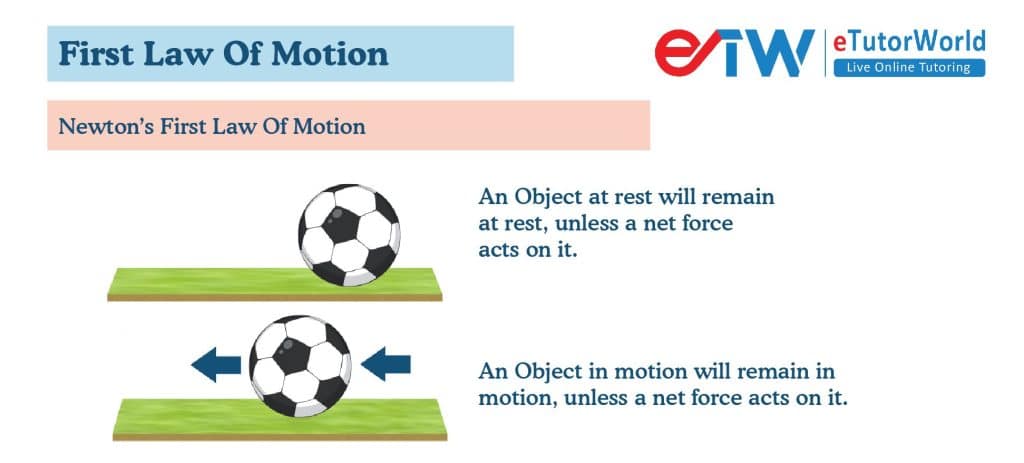Longitudinal Waves
Grade 6 Science Worksheets
The first law of motion, also known as the law of inertia, states that an object at rest will remain at rest, and an object in motion will remain in motion with a constant velocity unless acted upon by an external force.
Table of Contents:
- First Law of Motion
- Clauses
- FAQs
First Law of Motion - Grade 6 Science Worksheet PDF
This is a free printable / downloadable PDF worksheet with practice problems and answers. You can also work on it online.
|
|
Untimed |
|
Sign up with your email ID to access this free worksheet.
"We really love eTutorWorld!"
"We really love etutorworld!. Anand S and Pooja are excellent math teachers and are quick to respond with requests to tutor on any math topic!" - Kieran Y (via TrustSpot.io)
"My daughter gets distracted easily"
"My daughter gets distracted very easily and Ms. Medini and other teachers were patient with her and redirected her back to the courses.
With the help of Etutorworld, my daughter has been now selected in the Gifted and Talented Program for the school district"
- Nivea Sharma (via TrustSpot.io)
Sir Isaac Newton formulated the laws of motion in the 17th century based on his observations and experiments. He is considered to be one of the greatest scientists of all time and is known for his contributions to physics and mathematics.
Newton’s first law of motion was inspired by Galileo Galilei’s work on the concept of inertia, which describes the tendency of an object to resist changes in its motion. Newton’s second law of motion was developed from his experiments with falling objects and his understanding of the relationship between force, mass, and acceleration. His third law of motion was based on his observations of the interactions between objects and how they exert forces on each other.

In addition to his experiments and observations, Newton developed the mathematical tools needed to describe and analyze the behavior of objects in motion. He developed calculus and used it to develop equations that describe the relationships between force, mass, and motion.
The laws of motion have since become fundamental principles of physics, and they are used in various fields, such as engineering, biomechanics, and robotics, to design and build machines that operate efficiently and effectively.
The First Law Of Motion
The first law of motion, also known as the law of inertia, states that an object at rest will remain at rest, and an object in motion will remain in motion with a constant velocity unless acted upon by an external force. This means that an object will maintain its state of motion unless there is a net force acting on it.
The formula for the first law of motion is:
F_net=0
where F_net is the net force acting on the object.
Here are some examples of the first law of motion:
1. A book resting on a table will remain at rest until someone applies force to move it.
2. A ball rolling on a flat surface will continue to roll at a constant speed and in a straight line, unless acted upon by an external force, such as friction or gravity.
3. A satellite orbiting the Earth will continue to do so at a constant velocity unless acted upon by an external force, such as atmospheric drag or gravity from another celestial body.
4. A car driving down a straight road at a constant speed will continue to do so unless an external force, such as a strong wind or a change in the road surface, acts on the car.
In each of these examples, the object will continue to move with a constant velocity unless acted upon by an external force. The first law of motion helps us to understand why objects behave the way they do and is fundamental to our understanding of physics.
“There have been times when we booked them last minute, but the teachers have been extremely well-prepared and the help desk at etutorworld is very prompt.
Our kid is doing much better with a higher score.”
6th Grade Tutoring
eTutorWorld offers Personalized Online Tutoring for Math, Science, English, and Standardised Tests.
Our Tutoring Packs start at just under $22.49 per hour, and come with a moneyback guarantee.
Schedule a FREE Trial Session, and experience quality tutoring for yourself. (No credit card required.)
Clauses For The First Law Of Motion
The first law of motion is dependent on two circumstances:
1. Objects at rest: The velocity (v) and acceleration (a) of an object are both zero when it is at rest. The object remains at rest as a result.
2. During motion, an object’s velocity is greater than zero (v > 0), while its acceleration (a = 0) is also zero. As a result, the object will continue to move in the same direction and at the same speed.
Do You Stack Up Against the Best?
If you have 30 minutes, try our free diagnostics test and assess your skills.
First Law of Motion FAQS
What is the first law of motion?
The first law of motion, also known as the law of inertia, states that an object at rest will remain at rest, and an object in motion will remain in motion with a constant velocity unless acted upon by an external force.
What is meant by "inertia"?
Inertia is the tendency of an object to resist changes in its state of motion or rest. The greater the mass of an object, the greater its inertia, and the more force is required to change its state of motion.
How does the first law of motion apply to everyday life?
The first law of motion applies to many everyday situations. For example, when you push a cart or a chair, it will continue to move until it is stopped by a force such as friction or hitting an obstacle. Similarly, when you are in a moving vehicle and it suddenly stops, you will continue to move forward due to inertia until another force, such as a seatbelt, stops you.
What is an example of the first law of motion in sports?
A good example of the first law of motion in sports is a hockey puck sliding on ice. Once the puck is set in motion, it will continue to move with a constant velocity until it hits something or is stopped by friction.
How does the first law of motion relate to space travel?
The first law of motion is particularly important in space travel, as there is no air resistance to slow down or change the motion of spacecraft. A spacecraft in orbit around the Earth will continue to move with a constant speed unless acted upon by a force such as gravity or the thrust of its engines.

Kathleen Currence is one of the founders of eTutorWorld. Previously a middle school principal in Kansas City School District, she has an MA in Education from the University of Dayton, Ohio. She is a prolific writer, and likes to explain Science topics in student-friendly language. LinkedIn Profile
Affordable Tutoring Now Starts at Just $22.49
eTutorWorld offers affordable one-on-one live tutoring over the web for Grades K-12. We are also a leading provider of Test Prep help for Standardized Tests (SCAT, CogAT, MAP, SSAT, SAT, ACT, ISEE, and AP).
What makes eTutorWorld stand apart are: flexibility in lesson scheduling, quality of hand-picked tutors, assignment of tutors based on academic counseling and diagnostic tests of each student, and our 100% money-back guarantee.
Whether you have never tried personalized online tutoring before or are looking for better tutors and flexibility at an affordable price point, schedule a FREE TRIAL Session with us today.
*There is no purchase obligation or credit card requirement
Grade 6 Science Worksheets
- Inquiry process
- Nature of Science
- Scientific Inquiry
- Inquiry, Analysis and Problem Solving
- Ethical Practices
- Science and Society
- Biotic and Abiotic Factors
- Impact of Organisms
- Adaptation
- Spheres of Earth
- Natural Resources
- Environmental Issues
- Conservation of Earth
- Understanding Technology
- Abilities To Do Technological Design
- Structure of Earth
- Solar System
- Rocks and Fossils
- Earth Systems
- Plate Tectonics
- Evolution
- Magnetic Field of Earth
- Geologic Time
- Materials and Processes That Shape a Planet
- Astronomy
- Ecology
- Energy
- Kinetic and Potential Energy
- Energy Transfer
- Matter and its Structure
- States of Matter
- Physical and Chemical Changes
- Force and Motion
- Electricity and Magnetism
- Wave Interactions
- Sound
- Light
- Introduction to Life Science
- The Origin & History of Life On Earth
- Plant and Animal Cells
- Parts of a Cell
- The Cell Cycle
- How Living Organisms Get Energy
- Classification of Organisms
- How Plants Grow & Reproduce
- The Human Respiratory System
- The Human Cardiovascular System
- The Human Digestive System
- The Human Endocrine Systems
- The Human Nervous System
- The Human Muscular System
- The Human Skeletal System
IN THE NEWS

Our mission is to provide high quality online tutoring services, using state of the art Internet technology, to school students worldwide.
Online test prep and practice
SCAT
SSAT
ISEE
PSAT
SAT
ACT
AP Exam
Science Tutoring
Physics Tutoring
Chemistry Tutoring
Biology Tutoring
Math Tutoring
Pre-Algebra Tutoring
Algebra Tutoring
Pre Calculus Tutoring
Calculus Tutoring
Geometry Tutoring
Trigonometry Tutoring
Statistics Tutoring
Quick links
Free Worksheets
Fact sheet
Sales Partner Opportunities
Parents
Passive Fundraising
Virtual Fundraising
Our Expert Tutors
Safe and Secure Tutoring
Interactive Online Tutoring
After School Tutoring
Elementary School Tutoring
Middle School Tutoring
High School Tutoring
Home Work Help
Math Tutors New York City
Press
©2022 eTutorWorld Terms of use Privacy Policy Site by Little Red Bird
©2022 eTutorWorld
Terms of use
Privacy Policy
Site by Little Red Bird










